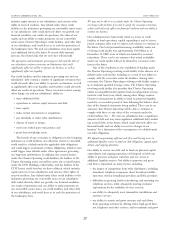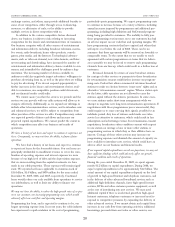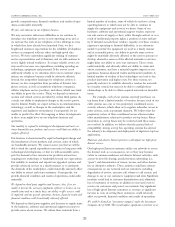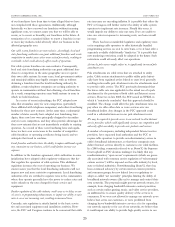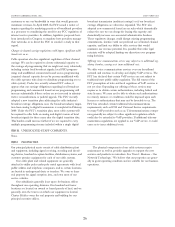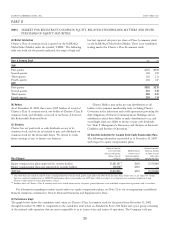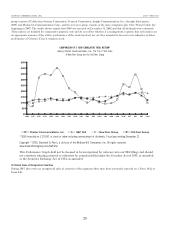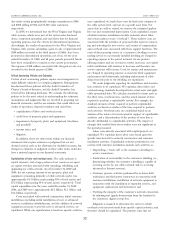Charter 2007 Annual Report Download - page 36
Download and view the complete annual report
Please find page 36 of the 2007 Charter annual report below. You can navigate through the pages in the report by either clicking on the pages listed below, or by using the keyword search tool below to find specific information within the annual report.
of our franchisors have from time to time alleged that we have
not complied with these agreements. Additionally, although
historically we have renewed our franchises without incurring
significant costs, we cannot assure you that we will be able to
renew, or to renew as favorably, our franchises in the future. A
termination of or a sustained failure to renew a franchise in one
or more key markets could adversely affect our business in the
affected geographic area.
Our cable system franchises are non-exclusive. Accordingly, local and
state franchising authorities can grant additional franchises and create
competition in market areas where none existed previously, resulting in
overbuilds, which could adversely affect results of operations.
Our cable system franchises are non-exclusive. Consequently,
local and state franchising authorities can grant additional fran-
chises to competitors in the same geographic area or operate
their own cable systems. In some cases, local government entities
and municipal utilities may legally compete with us without
obtaining a franchise from the local franchising authority. In
addition, certain telephone companies are seeking authority to
operate in communities without first obtaining a local franchise.
As a result, competing operators may build systems in areas in
which we hold franchises.
In a series of recent rulemakings, the FCC adopted new
rules that streamline entry for new competitors (particularly
those affiliated with telephone companies) and reduce franchising
burdens for these new entrants. At the same time, a substantial
number of states recently have adopted new franchising laws.
Again, these new laws were principally designed to streamline
entry for new competitors, and they often provide advantages for
these new entrants that are not immediately available to existing
operators. As a result of these new franchising laws and regula-
tions, we have seen an increase in the number of competitive
cable franchises or operating certificates being issued, and we
anticipate that trend to continue.
Local franchise authorities have the ability to impose additional regula-
tory constraints on our business, which could further increase our
expenses.
In addition to the franchise agreement, cable authorities in some
jurisdictions have adopted cable regulatory ordinances that fur-
ther regulate the operation of cable systems. This additional
regulation increases the cost of operating our business. We
cannot assure you that the local franchising authorities will not
impose new and more restrictive requirements. Local franchising
authorities who are certified to regulate rates in the communities
where they operate generally have the power to reduce rates and
order refunds on the rates charged for basic service and
equipment.
Further regulation of the cable industry could cause us to delay or can-
cel service or programming enhancements, or impair our ability to raise
rates to cover our increasing costs, resulting in increased losses.
Currently, rate regulation is strictly limited to the basic service
tier and associated equipment and installation activities. How-
ever, the FCC and Congress continue to be concerned that cable
rate increases are exceeding inflation. It is possible that either the
FCC or Congress will further restrict the ability of cable system
operators to implement rate increases. Should this occur, it
would impede our ability to raise our rates. If we are unable to
raise our rates in response to increasing costs, our losses would
increase.
There has been considerable legislative and regulatory inter-
est in requiring cable operators to offer historically bundled
programming services on an á la carte basis, or to at least offer a
separately available child-friendly “family tier.” It is possible that
new marketing restrictions could be adopted in the future. Such
restrictions could adversely affect our operations.
Actions by pole owners might subject us to significantly increased pole
attachment costs.
Pole attachments are cable wires that are attached to utility
poles. Cable system attachments to public utility poles histori-
cally have been regulated at the federal or state level, generally
resulting in favorable pole attachment rates for attachments used
to provide cable service. The FCC previously determined that
the lower cable rate was applicable to the mixed use of a pole
attachment for the provision of both cable and Internet access
services. However, in late 2007, the FCC issued an NPRM, in
which it “tentatively concludes” that this approach should be
modified. The change could affect the pole attachment rates we
pay when we offer either data or voice services over our
broadband facility. Any changes in the FCC approach could
result in a substantial increase in our pole attachment costs.
We may be required to provide access to our network to other Internet
service providers which could significantly increase our competition and
adversely affect our ability to provide new products and services.
A number of companies, including independent Internet service
providers, have requested local authorities and the FCC to
require cable operators to provide non-discriminatory access to
cable’s broadband infrastructure, so that these companies may
deliver Internet services directly to customers over cable facilities.
In a 2005 ruling, commonly referred to as Brand X, the Supreme
Court upheld an FCC decision making it less likely that any
nondiscriminatory “open access” requirements (which are gener-
ally associated with common carrier regulation of “telecommuni-
cations services”) will be imposed on the cable industry by local,
state or federal authorities. Notwithstanding Brand X, there has
been continued advocacy by certain internet content providers
and consumer groups for new federal laws or regulations to
adopt so-called “net neutrality” principles limiting the ability of
broadband network owners (like us) to manage and control their
own networks. The proposals might prevent network owners, for
example, from charging bandwidth intensive content providers,
such as certain online gaming, music, and video service providers,
an additional fee to ensure quality delivery of the services to
consumers. If we were not allowed to manage our network as we
believe best serves our customers, or were prohibited from
charging heavy bandwidth intensive services a fee for expanding
our network capacity or for use of our networks, we believe that
it could impair our ability to provide high quality service to our
CHARTER COMMUNICATIONS, INC. 2007 FORM 10-K
25




